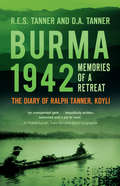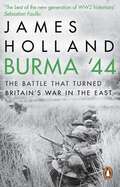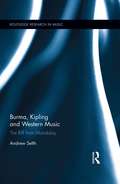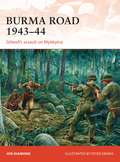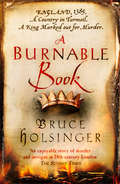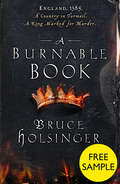- Table View
- List View
Burkina Faso: A History of Power, Protest, and Revolution
by Ernest HarschIn October 2014, huge protests across Burkina Faso succeeded in overthrowing the long-entrenched regime of their authoritarian ruler, Blaise Compaoré. Defying all expectations, this popular movement went on to defeat an attempted coup by the old regime, making it possible for a transitional government to organize free and fair elections the following year. In doing so, the people of this previously obscure West African nation surprised the world, and their struggle stands as one of the few instances of a popular democratic uprising succeeding in postcolonial sub-Saharan Africa.For over three decades, Ernest Harsch has researched and reported from Burkina Faso, interviewing subjects ranging from local democratic activists to revolutionary icon Thomas Sankara, the man once dubbed 'Africa's Che Guevara.' In this book, Harsch provides a compelling history of this little understood country, from the French colonial period to the Compaoré regime and the movement that finally deposed him.
The Burley manuscript (The Manchester Spenser)
by Peter RedfordA meticulous study of a significant early modern manuscript.
The Burley manuscript (The Manchester Spenser)
by Peter RedfordA meticulous study of a significant early modern manuscript.
Burma 1942: Memoirs of a Retreat: The Diary of Ralph Tanner, KOYLI
by R E Tanner D A TannerIn December 1941, a Japanese battalion of 143rd Regiment of 55th Division crossed the Burma-Siam border and siezed Victoria Point, heralding the invasion of Burma. The first air raids on Rangoon were opposed by only two fighter squadrons - 16 P40s of the American Volunteer Group (AVG) and 16 Buffaloes of the RAF. What followed was a fighting retreat as the British forces struggled to the Indian border, harried by an experienced Japanese force which was supported by at least 200 aircraft against the Allies' meagure fifty. 'Burma 1942' is a unique assessment of this disastrous episode in British military history, taken in part from the diary and maps kept by Ralph Tanner, who served with 2nd Battalion The Kings Own Yorkshire Light Infantry during the retreat, and from the official Battalion war diary by Major Chadwick. It includes background to the mobilisation of the Battalion in 1941, who they were, their equipment and what they were trained for, and considers the series of disasters at Moulmein, Sittang, Toksan and Yenangyaung which left them increasingly unable to fight as a unit. It also addresses the factors which prevented optimum military performance, includes discussions with the author's one-time enemies, and serves as a tribute to the strength of the men of the battalion - most of whom were conscripts - and of whom a fifth were killed and have no grave.
Burma 1942: The Road from Rangoon to Mandalay
by Alan WarrenIn December 1941 Japan set out to seize South-East Asia and the western Pacific to complete the building of a self-sufficient empire. The rapid loss of all of Britain's possessions in the Far East was the culmination of a failed attempt to deal with the rise of Japanese imperialism. Britain's bluff was called and millions of Britain's 'protected' subjects in Asia fell into the hands of a brutal occupying power. The British fought the Second World War in Burma and India against the backdrop of nationalist unrest and revolt. The appalling Bengal famine of 1943, brought about by the loss of Burma's rice crop and the dislocation of government, would cause the deaths of many. Alan Warren provides a new study of the series of battles that made up the Burma campaign, including first-hand accounts of the conflict and a fresh examination of the armies and commanders of the major combatants. Burma 1942 powerfully demonstrates how victory or defeat in particular battles altered the trajectory of the conflict, affecting the lives of millions.
Burma 1942: The Road from Rangoon to Mandalay
by Alan WarrenIn December 1941 Japan set out to seize South-East Asia and the western Pacific to complete the building of a self-sufficient empire. The rapid loss of all of Britain's possessions in the Far East was the culmination of a failed attempt to deal with the rise of Japanese imperialism. Britain's bluff was called and millions of Britain's 'protected' subjects in Asia fell into the hands of a brutal occupying power. The British fought the Second World War in Burma and India against the backdrop of nationalist unrest and revolt. The appalling Bengal famine of 1943, brought about by the loss of Burma's rice crop and the dislocation of government, would cause the deaths of many. Alan Warren provides a new study of the series of battles that made up the Burma campaign, including first-hand accounts of the conflict and a fresh examination of the armies and commanders of the major combatants. Burma 1942 powerfully demonstrates how victory or defeat in particular battles altered the trajectory of the conflict, affecting the lives of millions.
Burma '44: The Battle That Turned Britain's War in the East
by James Holland'A first-rate popular history of a fascinating and neglected battle . . . James Holland is a master of spinning narrative military history from accounts of men and women who were there and BURMA ’44 is a veritable page-turner' BBC History In February 1944, a rag-tag collection of clerks, drivers, doctors, muleteers, and other base troops, stiffened by a few dogged Yorkshiremen and a handful of tank crews managed to hold out against some of the finest infantry in the Japanese Army, and then defeat them in what was one of the most astonishing battles of the Second World War.What became know as The Defence of the Admin Box, fought amongst the paddy fields and jungle of Northern Arakan over a fifteen-day period, turned the battle for Burma. Not only was it the first decisive victory for British troops against the Japanese, more significantly, it demonstrated how the Japanese could be defeated. The lessons learned in this tiny and otherwise insignificant corner of the Far East, set up the campaign in Burma that would follow, as General Slim’s Fourteenth Army finally turned defeat into victory.Burma '44 is a tale of incredible drama. As gripping as the story of Rorke's drift, as momentous as the battle for the Ardennes, the Admin Box was a triumph of human grit and heroism and remains one of the most significant yet undervalued conflicts of World War Two.
Burma Boy
by Biyi BandeleA few months ago fourteen-year-old Ali Banana was apprenticed to a whip-wielding blacksmith in his rural hometown. Now its winter 1944, the war is entering its most crucial stage and Ali is a private in Thunder Brigade. His unit has been given orders to go behind enemy lines and wreak havoc. But the Burmese jungle is a mud-riven, treacherous place, riddled with Japanese snipers, insanity and disease. Burma Boy is a horrific, vividly realised account of the madness, the sacrifice and the dark humour of the Second World War's most vicious battleground. It's also the moving story of a boy trying to live long enough to become a man.
The Burma Campaign: Disaster into Triumph 1942-45 (Yale Library Of Military History Ser.)
by Frank McLynnThe Burma Campaign was one of the most punishing and protracted military adventures of World War Two. Impenetrable jungle, poor transport infrastructure, seasonal monsoon rains, as well as famine, disease, snakes and crocodiles all bore heavily on the troops. Against this extraordinary backdrop, Frank McLynn constructs the dramatic story of the four larger-than-life commanders directing the Allied effort: Louis Mountbatten, Orde Wingate, Joseph Stilwell and William Slim, and explores the Campaign through their often stormy relationship. Vivid, brutal, utterly enthralling, The Burma Campaign is a strikingly original account from one of our most celebrated historians.
Burma, Kipling and Western Music: The Riff from Mandalay (Routledge Research in Music)
by Andrew SelthFor decades, scholars have been trying to answer the question: how was colonial Burma perceived in and by the Western world, and how did people in countries like the United Kingdom and United States form their views? This book explores how Western perceptions of Burma were influenced by the popular music of the day. From the First Anglo-Burmese War of 1824-6 until Burma regained its independence in 1948, more than 180 musical works with Burma-related themes were written in English-speaking countries, in addition to the many hymns composed in and about Burma by Christian missionaries. Servicemen posted to Burma added to the lexicon with marches and ditties, and after 1913 most movies about Burma had their own distinctive scores. Taking Rudyard Kipling’s 1890 ballad ‘Mandalay’ as a critical turning point, this book surveys all these works with emphasis on popular songs and show tunes, also looking at classical works, ballet scores, hymns, soldiers’ songs, sea shanties, and film soundtracks. It examines how they influenced Western perceptions of Burma, and in turn reflected those views back to Western audiences. The book sheds new light not only on the West’s historical relationship with Burma, and the colonial music scene, but also Burma’s place in the development of popular music and the rise of the global music industry. In doing so, it makes an original contribution to the fields of musicology and Asian Studies.
Burma, Kipling and Western Music: The Riff from Mandalay (Routledge Research in Music)
by Andrew SelthFor decades, scholars have been trying to answer the question: how was colonial Burma perceived in and by the Western world, and how did people in countries like the United Kingdom and United States form their views? This book explores how Western perceptions of Burma were influenced by the popular music of the day. From the First Anglo-Burmese War of 1824-6 until Burma regained its independence in 1948, more than 180 musical works with Burma-related themes were written in English-speaking countries, in addition to the many hymns composed in and about Burma by Christian missionaries. Servicemen posted to Burma added to the lexicon with marches and ditties, and after 1913 most movies about Burma had their own distinctive scores. Taking Rudyard Kipling’s 1890 ballad ‘Mandalay’ as a critical turning point, this book surveys all these works with emphasis on popular songs and show tunes, also looking at classical works, ballet scores, hymns, soldiers’ songs, sea shanties, and film soundtracks. It examines how they influenced Western perceptions of Burma, and in turn reflected those views back to Western audiences. The book sheds new light not only on the West’s historical relationship with Burma, and the colonial music scene, but also Burma’s place in the development of popular music and the rise of the global music industry. In doing so, it makes an original contribution to the fields of musicology and Asian Studies.
Burma/Myanmar: What Everyone Needs to Know® (What Everyone Needs To Know®)
by David SteinbergNo country in Asia in recent years has undergone so massive a political shift in so short a time as Myanmar. Until recently, the former British colony had one of the most secretive, corrupt, and repressive regimes on the planet, a country where Nobel Peace Prize laureate Aung San Suu Kyi was held in continual house arrest and human rights were denied to nearly all. Yet events in Myanmar since the elections of November 2010 have profoundly altered the internal mood of the society, and have surprised even Burmese and seasoned foreign observers of the Myanmar scene. The pessimism that pervaded the society prior to the elections, and the results of that voting that prompted many foreign observers to call them a "sham" or "fraud," gradually gave way to the realization that positive change was in the air. In this updated second edition of Burma/Myanmar: What Everyone Needs to Know®, Davd I. Steinberg addresses the dramatic changes in the country over the past two years, including the establishment of a human rights commission, the release of political prisoners, and reforms in health and education. More than ever, the history, culture, and internal politics of this country are crucial to understanding the current transformation, which has generated headlines across the globe. Geographically strategic, Burma/Myanmar lies between the growing powers of China and India. Yet it is mostly unknown to Westerners despite being its thousand-year history as a nation. Burma/Myanmar is a place of contradictions: a picturesque land with mountain jungles and monsoon plains, it is one of the world's largest producers of heroin. Though it has extensive natural resources including oil, gas, teak, metals, and minerals, it is one of the poorest countries in the world. And despite a half-century of military-dominated rule, change is beginning to work its way through the beleaguered nation, as it moves to a more pluralistic administrative system reflecting its pluralistic cultural and multi-ethnic base. Authoritative and balanced, Burma/Myanmar is an essential book on a country in the throes of historic change. What Everyone Needs to Know® is a registered trademark of Oxford University Press.
Burma/Myanmar: What Everyone Needs to Know® (What Everyone Needs To Know®)
by David SteinbergNo country in Asia in recent years has undergone so massive a political shift in so short a time as Myanmar. Until recently, the former British colony had one of the most secretive, corrupt, and repressive regimes on the planet, a country where Nobel Peace Prize laureate Aung San Suu Kyi was held in continual house arrest and human rights were denied to nearly all. Yet events in Myanmar since the elections of November 2010 have profoundly altered the internal mood of the society, and have surprised even Burmese and seasoned foreign observers of the Myanmar scene. The pessimism that pervaded the society prior to the elections, and the results of that voting that prompted many foreign observers to call them a "sham" or "fraud," gradually gave way to the realization that positive change was in the air. In this updated second edition of Burma/Myanmar: What Everyone Needs to Know®, Davd I. Steinberg addresses the dramatic changes in the country over the past two years, including the establishment of a human rights commission, the release of political prisoners, and reforms in health and education. More than ever, the history, culture, and internal politics of this country are crucial to understanding the current transformation, which has generated headlines across the globe. Geographically strategic, Burma/Myanmar lies between the growing powers of China and India. Yet it is mostly unknown to Westerners despite being its thousand-year history as a nation. Burma/Myanmar is a place of contradictions: a picturesque land with mountain jungles and monsoon plains, it is one of the world's largest producers of heroin. Though it has extensive natural resources including oil, gas, teak, metals, and minerals, it is one of the poorest countries in the world. And despite a half-century of military-dominated rule, change is beginning to work its way through the beleaguered nation, as it moves to a more pluralistic administrative system reflecting its pluralistic cultural and multi-ethnic base. Authoritative and balanced, Burma/Myanmar is an essential book on a country in the throes of historic change. What Everyone Needs to Know® is a registered trademark of Oxford University Press.
Burma Road 1943–44: Stilwell's assault on Myitkyina (Campaign)
by Peter Dennis Jon DiamondMyitkyina was a vital objective in the Allied re-conquest of Burma in 1943–44. Following the disastrous retreat from Burma in April 1942, China had become isolated from re-supply except for the dangerous air route for US transports over the Himalaya Mountains. The Burma Road, which ran from Lashio (south of Myitkyina) through the mountains to Kunming was closed as a supply route from Rangoon after the Japanese conquest. Without military assistance, China would be forced to surrender and Imperial Japanese Army forces could be diverted to other Pacific war zones.This is the history of the ambitious joint Allied assault led by American Lt. Gen. Joseph W Stilwell and featuring British, American and Chinese forces as they clashed with three skilled regiments of the Japanese 18th Division. Packed with first-hand accounts, specially commissioned artwork, maps and illustrations and dozens of rare photographs this book reveals the incredible Allied attack on Myitkyina.
Burma Road 1943–44: Stilwell's assault on Myitkyina (Campaign #289)
by Peter Dennis Jon DiamondMyitkyina was a vital objective in the Allied re-conquest of Burma in 1943–44. Following the disastrous retreat from Burma in April 1942, China had become isolated from re-supply except for the dangerous air route for US transports over the Himalaya Mountains. The Burma Road, which ran from Lashio (south of Myitkyina) through the mountains to Kunming was closed as a supply route from Rangoon after the Japanese conquest. Without military assistance, China would be forced to surrender and Imperial Japanese Army forces could be diverted to other Pacific war zones.This is the history of the ambitious joint Allied assault led by American Lt. Gen. Joseph W Stilwell and featuring British, American and Chinese forces as they clashed with three skilled regiments of the Japanese 18th Division. Packed with first-hand accounts, specially commissioned artwork, maps and illustrations and dozens of rare photographs this book reveals the incredible Allied attack on Myitkyina.
Burma Victory: Imphal, Kohima and the Chindits – March 1944 to May 1945 (Osprey Digital Ser.)
by David RooneyIn the final years of World War II, the campaign against Japan stepped up in a series of bloody battles with each side having much to lose. While much of the history of the period focuses on the Pacific Campaign and the American island hopping, this book studies the 'forgotten war' and the Allied fight to push the Japanese out of Burma. The Allies (British, American, Indian and Chinese soldiers) saw the battles of Imphal and Kohima as a way to avenge the crushing defeats of 1942, while the Japanese viewed the battles as the precursor to a victorious drive into India and domination of Asia. David Rooney examines the aims of both sides alongside the battles themselves, which secured victory in Burma, and the roles of Wingate, Stilwell and the Chindits. Following the defeats of 1942 the Allies re-emerged to fight the Japanese; their troops had seen a revival of morale with the new Fourteenth Army under General Slim and the development of new tactics and and Allied air and firepower superiority.
Burma Victory: Imphal, Kohima and the Chindits – March 1944 to May 1945
by David RooneyIn the final years of World War II, the campaign against Japan stepped up in a series of bloody battles with each side having much to lose. While much of the history of the period focuses on the Pacific Campaign and the American island hopping, this book studies the 'forgotten war' and the Allied fight to push the Japanese out of Burma. The Allies (British, American, Indian and Chinese soldiers) saw the battles of Imphal and Kohima as a way to avenge the crushing defeats of 1942, while the Japanese viewed the battles as the precursor to a victorious drive into India and domination of Asia. David Rooney examines the aims of both sides alongside the battles themselves, which secured victory in Burma, and the roles of Wingate, Stilwell and the Chindits. Following the defeats of 1942 the Allies re-emerged to fight the Japanese; their troops had seen a revival of morale with the new Fourteenth Army under General Slim and the development of new tactics and and Allied air and firepower superiority.
Burmese Administrative Cycles: Anarchy and Conquest, c. 1580-1760 (PDF)
by Victor B. LiebermanThis book is the first detailed study of administration and politics in premodern Burma and one of the few works of its kind for mainland Southeast Asia.Originally published in 1984.The Princeton Legacy Library uses the latest print-on-demand technology to again make available previously out-of-print books from the distinguished backlist of Princeton University Press. These editions preserve the original texts of these important books while presenting them in durable paperback and hardcover editions. The goal of the Princeton Legacy Library is to vastly increase access to the rich scholarly heritage found in the thousands of books published by Princeton University Press since its founding in 1905.
Burmese Days (Collins Classics #Vol. 2)
by George OrwellHarperCollins is proud to present its incredible range of best-loved, essential classics.
Burmese Lives: Ordinary Life Stories Under the Burmese Regime
This volume explores the life stories of ordinary Burmese by drawing on the narratives of individual subjects and using an array of interdisciplinary approaches, covering anthropology, history, literature, ethnomusicology, economics and political science. Burma is one of the most diverse societies in Southeast Asia in terms of its ethnic composition. It has a long history of resistance from the public realm against colonial rule and post-independence regimes. However, its isolation for decades before 1988 deprived scholars of a close look into the many faces of this society. Looking into the life stories of members of several major ethnic communities, who hail from different occupations and are of different ages and genders, this book has a particular significance that would help reveal the multiplicities of Burma's modern history. The authors of this volume write about stories of their long-term informants, close friends, family members, or even themselves to bring out a wide range of issues relating to migration, economy, politics, religion and culture. The constituted stories jointly highlight the protagonists' survival strategies in everyday life that demonstrate their constant courage, pain and frustration in dealing with numerous social injustices and adversities. Through these stories, we see movement of lives as well as that of Burmese society.
Burn My Heart
by Beverley NaidooThe Mau Mau - the name of a secret society that once struck terror into the hearts of British settlers in Kenya. An episode in history that ended in a State of Emergency, with violent and brutal acts dividing a nation. This is an intensely personal and vivid story of two boys: one black, one white. Once they were friends even though their circumstances are very different. But in a country driven by fear and prejudice, even the best of friends can betray one another . . .Internationally acclaimed and award-winning author Beverley Naidoo explores new territory in this beautifully realized and moving story set in Britain's colonial past.
Burn Out: The Endgame for Fossil Fuels
by Dieter HelmAn energy revolution is under way with far-reaching consequences for nations, companies, and the way we address climate change Low oil prices are sending shockwaves through the global economy, and longtime industry observer Dieter Helm explains how this and other shifts are the harbingers of a coming energy revolution and how the fossil fuel age will come to an end. Surveying recent surges in technological innovations, Helm’s provocative new book documents how the global move toward the internet-of-things will inexorably reduce the demand for oil, gas, and renewables—and prove more effective than current efforts to avert climate change. Oil companies and energy utilities must begin to adapt their existing business models or face future irrelevancy. Oil-exporting nations, particularly in the Middle East, will be negatively impacted, whereas the United States and European countries that are investing in new technologies may find themselves leaders in the geopolitical game. Timely and controversial, this book concludes by offering advice on what governments and businesses can and should do now to prepare for a radically different energy future.
Burn the Sea: Flame Warfare, Black Propaganda and the Nazi Plan to Invade England
by James HaywardIn the whole course of the war,’ conceded Britain’s chief press censor, ‘there was no story which gave me so much trouble as that of the attempted German invasion, flaming oil on the water and 30,000 burned Germans.’ Sparked by the Directorate of Military Intelligence and MI6, rumours that Britain had set fire to the English Channel to defeat a German invasion in 1940 quickly spread around the world. Highly popular in America, the incendiary ‘Big Lie’ became Britain’s first significant propaganda victory of the Second World War. Yet the unlikely deception was founded in fact. Dead German soldiers were washed ashore on British beaches, a secret Petroleum Warfare Department tested lethal flame barrages on land and sea, and fire ships were hastily dispatched to enemy ports as part of Operation Lucid. British intelligence agencies even managed to plant the burning sea story on their opposite numbers in Nazi Germany. Burn the Sea is the definitive account of the origin, circulation and astonishing longevity of the myth of the ‘invasion that failed’ in 1940, as well as its remarkable revival in 1992.
A Burnable Book: A Novel
by Bruce HolsingerA stunning debut historical thriller set in the turbulent 14th Century for fans of CJ Sansom, The Name of the Rose and An Instance of the Fingerpost.
A Burnable Book: Free Sampler
by Bruce HolsingerTRY A FREE SAMPLE OF THIS STUNNING DEBUT HISTORICAL THRILLER. Set in the turbulent 14th Century, this is perfect for fans of CJ Sansom, The Name of the Rose and An Instance of the Fingerpost.



